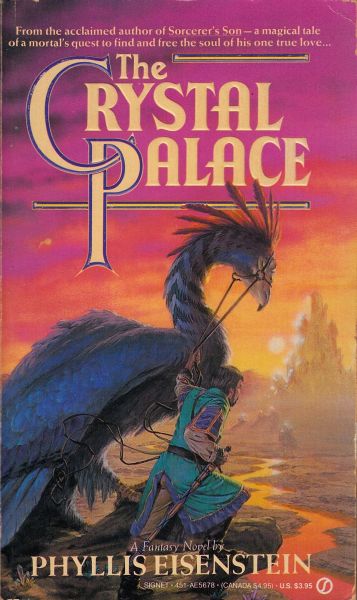Melt Your Heart
The Crystal Palace (Book of Elementals, volume 2)
By Phyllis Eisenstein

2 Apr, 2024
1988’s The Crystal Palace is the second volume in Phyllis Eisenstein’s secondary universe fantasy Book of Elementals series. I reviewed the first volume, Sorcerer’s Son, here.
Having vanquished Sorcerer Rezhyk, nothing remains for sorcerer Detivev Ormoru and her son Cray but to live happily ever after. Easy enough for Detivev, who has her doting demon lover Gildrum. Easy enough for all the demons liberated by the relentless Cray. But where is Cray’s happily ever after?
The answer begins with a magic mirror.
The Seer Sepwin has constructed a mirror in which the viewer’s heart’s desire can be seen. It shows images without any explanation. Cray looks in the mirror and sees a girl who is presumably his heart’s desire. However, he has no idea who she is or where to find her. He dithers. The next time he looks in the mirror, the girl has grown. At last, he sets out to find her.
After great difficulties, Cray learns that Aliza is a human woman who lives in a crystal palace in a supernatural realm of ice. He appears unannounced at her home, hoping to befriend the woman in the mirror.
Aliza remains oddly cool to Cray. Perhaps this is because she seems to have no soul. Aliza’s grandfather Everand, the sorcerer who imprisoned Aliza in the crystal palace, might be able to explain the matter? Asking would be futile, as Everand has good reason to conceal what he is up to. As well, although neither man knows it, Cray is Everand’s bitterest enemy.
~oOo~
This series started out at publisher Del Rey with Sorceror’s Son1. The next volume in the series, this one, was published by Signet. At first glance I thought Signet had commissioned another cover by Darrel Sweet for consistency of appearance. In fact, the artist was Richard Hescox, whose art I had not thought similar to Sweet’s.
Why the friction between two men who have never met? Everand is a sorcerer and like all sorcerers, gets his power by enslaving demons. He covets more demons to enslave. Cray has spent years freeing demons and placing them beyond sorcerous control. He is thus a bitter enemy to (almost) all sorcerers2. Good thing for Cray that the freed demons have refused to reveal who freed them. Although Everand has no idea who the liberator is, he knows that there is one and been searching for the person’s name without success… at least by the time the novel begins.
Whereas Rezhyk, the antagonist in the previous volume, was dangerous because he was powerful3, Everand is dangerous because he is weak. Having been victimized by other sorcerers in the past, he is determined to become as powerful as his abusers. Lacking sorcerous aptitude, Everand does his very best to compensate with a degree of ruthlessness that is unusual even for sorcerers.
It is fortunate indeed for Cray that the author is his ally. If she weren’t, perhaps readers might think Cray a stalker. He tracks Aliza down and shows up expecting to be received as a friend. He sees himself as a hero rescuing a maiden from bondage. But the reality is that Aliza is content with her life. She has a demon friend and spends her time studying magic.
But the author reveals that Aliza is after all in great danger and that Cray is ideally suited to save her. He’s a hero, not a stalker, and all is well.
The moral: before embarking on a one-sided romance, establish that you are the protagonist and not just a creep.
Despite such reservations, I ended up liking the book. It’s well-written and well-paced. Even though the book was 382 pages, I galloped through it. Not great literature, but a pleasant time pass.
The Crystal Palace is out of print.
1: If I am reading the ISFDB correctly, Eisenstein’s first few novels published in the USA were put out by Dell. There was one exception, Sorcerer’s Son, from Del Rey. Then she moved the series to Signet, and finally to Meisha Merlin, who burned her career down to the water-line.
2: Cray is, of course, not his mother’s enemy. She doesn’t need demonic slaves to have power. Cray is a sorcerer, but he doesn’t need to enslave demons; he just asks grateful freed demons for favors.
Demons do not like being enslaved. With the legions of freed demons growing every day, one has to wonder if the demons are taking revenge for their enslavement. If that’s so, any list of sorcerers would be shortening rapidly.
3: Everand is paranoid. In this secondary universe, many sorcerers seem to be paranoid, and for good reason. Sorcery depends on enslaving demons. Sorcerers do not limit themselves to victimizing demons; anyone weaker is seen as fair game.
